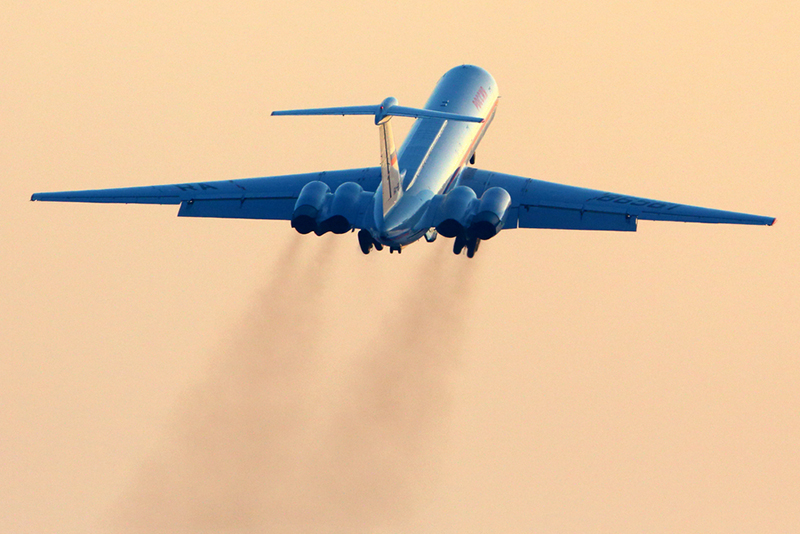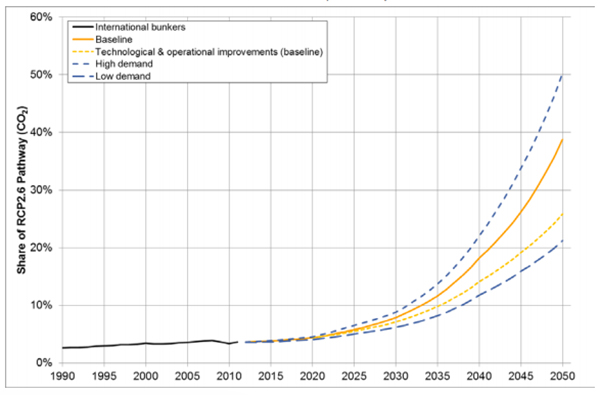In the global effort to reduce carbon emissions, the aviation and shipping industries have been the most conspicuous outliers. Although these two sectors currently contribute 6 percent of all manmade CO2 emissions, they have managed to remain outside international control.

But in the wake of the historic United Nations climate agreement reached in Paris in December, the pressure is finally on to rein in these two big freeloaders.
International aviation and shipping emissions were excluded from the Paris pact, which introduced limits on greenhouse gas emissions for all nations starting in 2020. With power generation, manufacturing, domestic transport, deforestation, and even changes in land use all now constrained, calls are growing for these two big sectors to be tamed as well.
Aviation and shipping each emit roughly the same volume of CO2 annually as the U.K. or Germany, and unlike the emissions of those two countries, their greenhouse gases continue to rise dramatically. Between 1990 and 2010, their contributions to the accumulation of planet-warming CO2 in the atmosphere rose by an average 3 percent a year, three times faster than overall global CO2 emissions.
According to a study by University College London’s Energy Institute, aviation and shipping are on target to increase their contributions to overall CO2 emissions from today’s 6 percent to 40 percent by 2050, even as emissions from other sectors are slashed.
By the end of the year, the U.N. agencies charged with controlling aviation and shipping will decide whether to cap their emissions in line with the Paris Agreement. If they cannot, then calls by scientists, activists, and climate negotiators for the decisions to be taken out of the industries’ hands will intensify.
International transportation has been left out of U.N. agreements on fighting climate change because it does not fit easily into control regimes, such as the Kyoto Protocol and the Paris Agreement, which are based on national targets.
Which nation should be responsible, say, for a flight from Mexico City to New York, or a container ship heading from Shanghai to Los Angeles? Should the emissions be logged with the country where the plane or ship departs, or where it arrives, or according to its national flag or legal jurisdiction, or where it takes on fuel, or according to who or what is on board?
While airlines are backing emissions controls, the shipping industry remains in denial.
All these approaches have been proposed. And with different nations having very different kinds of emissions targets, finding the answer is a political minefield.
So far, the solution to this conundrum has been simply to exclude international transportation from national targets altogether and have these industries police their own emissions through their respective UN regulators — the London-based International Maritime Organization (IMO) and the Montreal-based International Civil Aviation Organization (ICAO).
In theory, this makes some sense. Indeed, some within these industries have argued that it should be an advantage, giving them the chance to establish global standards based on optimum technical solutions, which would bring down emissions faster than a tangle of national targets and exemptions.
But it hasn’t worked out like that. Those two agencies have spent most of the 24 years since the UN Framework Convention on Climate Change was agreed in 1992 doing virtually nothing, while watching the emissions from aviation and shipping soar far faster than other industrial sectors.
In practice, the call for a common industry-wide approach to emissions control caused a political logjam. Developing nations argued that since they have not until now had to meet targets for domestic emissions, there was no basis for requiring their companies to meet international industry targets. Meanwhile, companies based in rich nations said they would not act unless everyone did.
The fact that companies from rich and poor nations compete directly on aviation and shipping routes became a basis for stasis rather than collective advance. And with shipping, the problem has been further complicated by international lines that registered their ships in nations with lax regulatory systems, known as “flags of convenience.” Two-thirds of the world’s ships are registered in small non-industrial countries such as Panama, Liberia, and the Marshall Islands.
Following the Paris Agreement, however, the stakes are raised. The idea of international transportation operating outside emissions controls makes even less sense than before. In response, the ICAO is promising an agreement on aviation emissions at its meeting in October that will deliver “carbon-neutral growth from 2020.”

With airlines responsible for 90 percent of aviation traffic backing the proposals, an agreement should be reached. But the shipping industry, according to observers after the IMO’s most recent environment committee meeting in April, remains in denial.
The aviation industry was pushed into action by a plan drawn up by the European Union in 2012. It required airlines flying into European airports to, in effect, pay a tax on emissions
by being required to subscribe to the EU’s existing emissions trading scheme and buy permits for the pollution they cause. The industry challenged the European plan under international law, which prohibits national taxes on international aviation. But, in return for the EU putting the plan on hold, the ICAO agreed to draw up its own proposals.
The political pressure to push through an aviation emissions cap is growing. Without a deal, the EU has promised to revisit its trading-scheme plan. And President Obama, in a joint announcement with Canadian Prime Minister Justin Trudeau earlier this year, pledged to get an ICAO deal before he leaves office.
Under the ICAO’s draft plan, aviation emissions will be capped at 2020 levels. Airlines will have to prevent any further increases in their emissions after that date. Any unavoidable increases will have to be offset, either by airlines trading emissions rights among themselves, or by investing in offset schemes such as reforestation or forest conservation to soak up the excess CO2.
Current industry projections see aviation activity increasing between three- and four-fold by 2040, according to an analysis by Annie Petsonk of the Environmental Defense Fund (EDF) in Washington, D.C. More efficient planes can reduce emissions slightly below that.
The aviation industry is expected to meet the bulk of its commitments through carbon offsets.
And the ICAO has proposed a CO2 efficiency standard for aircraft to encourage reduced emissions through more fuel-efficient routing, as well as better engines and lighter materials in the 50,000 new large aircraft expected to take to the skies by 2040.
But Petsonk still expects annual emissions of CO2 from international aviation to be 7.8 billion tons higher in 2040 than today. That is an increase roughly equivalent to current U.S. national emissions from all activities.
One way out would be to convert planes to burning biofuels. If those crop-based fuels are sustainably produced, airlines could mark such flights as zero emitters. Virgin and Lufthansa have run commercial flights on biofuels, but they have yet to go mainstream. In any event, the carbon neutrality of biofuels is widely contested by environmental groups, and turning large areas of land over to their production could threaten food security in some countries.
So few doubt that, assuming the ICAO deal goes through, the industry will meet the bulk of its commitments through offsets, which an industry report in 2013 called “the quickest [solution] to implement, the easiest to administer, and the most cost-efficient.”
Last month, the Environmental Defense Fund, The Nature Conservancy, and Conservation International all backed the offsetting option, urging aviation to puts its money into the U.N.’s Reducing Emissions from Deforestation and Forest Degradation (REDD) program, which channels funds into conservation of forests as carbon sinks. These groups called this approach “essential” to meet the stabilization target.
But not all environmental organizations agree. Some, including Greenpeace and a host of European NGOs, believe forest conservation offsets do little in practice to protect forests and are prone to fraud and double-counting, in which various organizations funding forest conservation each end up claiming the supposed carbon benefit.
Though the ICAO has pledged to prevent double-counting, critics fear that airlines will simply fund projects to which national governments are already committed under the Paris agreement. If that happens, then there would be no additional offsets at all, and aviation’s emissions would continue to accumulate in the atmosphere.

But at least aviation is now engaged in a discussion about how to comply with its pledges. The shipping industry, in contrast, remains unsure about whether it wants to commit to curbing its emissions at all — even though the IMO’s own estimates suggest shipping emissions will rise by 250 percent by 2050 and could by then make up 17 percent of all global emissions.
Carbon emissions standards on individual new ships that will be introduced from 2019 will reduce emissions per ton of cargo. But the IMO has no plans to extend the standards to existing shipping or to impose caps on the industry’s overall emissions.
Last September, the IMO’s then-secretary general Koji Sekimizu said shipping emissions should not be capped because to do so could damage economic growth. “Such measures would artificially limit the ability of shipping to meet the demand created by the world economy, or would unbalance the level playing field that the shipping industry needs for efficient operation, and therefore must be avoided,” he said.
In April, the IMO’s environment committee sat down to discuss the matter, coincidentally on the same day that 175 nations met at the UN in New York to sign the Paris agreement. But rather than seizing the moment, the committee’s sole concession to the clamor for action was to agree to require all ships weighing more than 5,000 tons to submit data on fuel use.
While the EU and two of the three nations with the largest “flag of convenience” shipping fleets — Liberia and the Marshall Islands — backed drawing up plans to bring shipping into line on emissions curbs, they met fierce opposition. Russia, China, India, Brazil, and the third major flag of convenience state, Panama, all put up strong resistance to any idea of substantive talks on limiting emissions.
One shipping company cut CO2 emissions by 30 percent simply by telling the captains to travel more slowly.
This veto from big developing nations has angered some major players in the industry, including a group called the Sustainable Shipping Initiative (SSI), whose members include major shipping lines such as the Danish giant Maersk, cruise company Carnival, and big users of shipping such as Cargill, the commodities conglomerate.
Before the committee met, the SSI had called for a commitment from the industry to cut fuel use by 20 percent a decade from now on. After the failure of the April meeting, it warned that outside agencies could soon intervene.
Alastair Fischbacher, the group’s CEO, says the last chance for the industry to act could be the next meeting of the IMO environment committee in October. That will come days after the ICAO is expected to sign off on its own cap on aviation emissions. And it will be less than two months before the UN climate negotiators, buoyed by their Paris deal, next meet in Morocco. If the IMO committee fails to act, it would leave the shipping industry as a lone holdout against firm emissions targets to fight climate change.
“The shipping industry cannot go to Morocco without a process for emissions reductions. It would simply be unacceptable,” Fischbacher told Yale Environment 360. “Not only would it damage the industry’s reputation, it would also run the risk of external regulators taking the matter into their own hands and circumnavigating the IMO.”
Despite the IMO’s reluctance, making big reductions in emissions from shipping is not that difficult. A lot could be done to improve the fuel efficiency of shipping. Maersk says that during the economic slump after 2008, when shipping fleets had huge surplus capacity, the company cut fuel use and CO2 emissions by 30 percent simply by telling the captains of its massive container ships to travel more slowly.
ALSO FROM YALE e360Can We Reduce CO2 Emissions And Grow the Global Economy?

And the International Chamber of Shipping says better-designed engines, hulls, and propellers could cut emissions by a further 15-20 percent.
Different fuels for ships could also make a big difference. Maersk has conducted trials with biofuels. Carnival recently ordered the world’s first cruise ship powered by liquefied natural gas. And engineers are working on designs for ships powered by the sun or even a return to sails. But Fischbacher says for these innovations to be widely adopted, “there needs to be a mandatory incentive with global targets.”
“Shipping and aviation are in a similar situation today,” he says. “If left unchecked, their greenhouse gas emissions are set to rise exponentially by 2050. So far, both have failed to implement meaningful measures.” Yet while aviation seems to be facing up to the challenges of a carbon-constrained world, shipping looks like the last holdout.